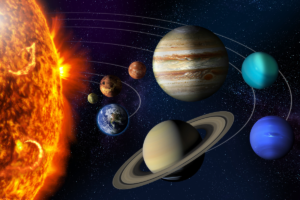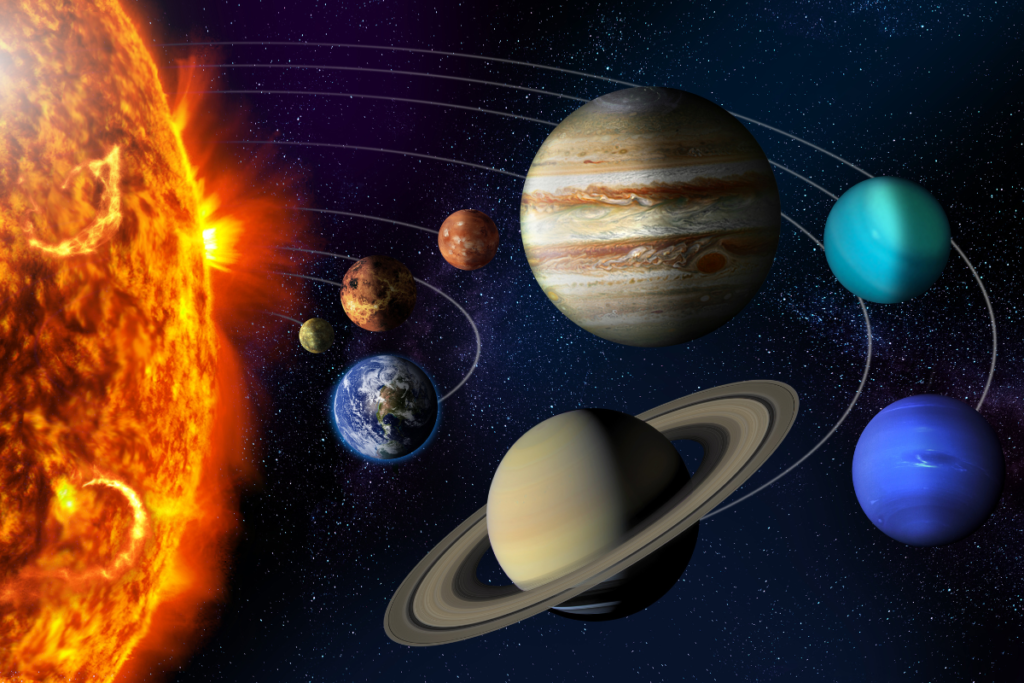Introduction
Ever wonder why the Earth, Moon, and Sun move in such perfect harmony? It’s like a celestial ballet, where everything moves in perfect synchrony. But the way these bodies interact isn’t just about gravity and motion—there’s so much more to it. Understanding the orbits of the Earth, Moon, and Sun not only helps us grasp the mechanics of our solar system but also explains phenomena like seasons, tides, and eclipses.
Let’s dive into the fascinating dance between these three celestial bodies and see how their orbits influence everything from the tides in our oceans to the phases of the Moon.
Understanding the Celestial Dance
The movement of the Earth, Moon, and Sun is like a never-ending cosmic performance. These three bodies are connected by the invisible but powerful force of gravity. Together, they form a system where their orbits are intricately linked. While the Earth revolves around the Sun, the Moon revolves around the Earth. And the Sun, being the star at the center of our solar system, provides the light and warmth that make life possible.
But how do these orbits work? Let’s break it down.
The Earth’s Orbit Around the Sun
Our planet Earth orbits the Sun once every 365.25 days, creating the yearly cycle we call a “year.” This orbit isn’t a perfect circle; it’s actually slightly elliptical, meaning that at certain times of the year, Earth is closer to the Sun, and at others, it’s farther away. However, this difference is so small that it doesn’t drastically affect temperatures.
Perihelion and Aphelion
At its closest point to the Sun, Earth reaches what we call “perihelion,” which usually happens around early January. The farthest point, known as “aphelion,” occurs in early July. Surprisingly, even though Earth is closer to the Sun in January, it doesn’t make winter hotter for those in the northern hemisphere. That’s because seasons are controlled by the Earth’s tilt, not its proximity to the Sun.
Tilt of Earth’s Axis and Its Effects
Earth’s axis is tilted at about 23.5 degrees. This tilt is responsible for the changing seasons. When one hemisphere is tilted toward the Sun, it experiences summer, while the opposite hemisphere, tilted away from the Sun, experiences winter. This explains why when it’s winter in the northern hemisphere, the southern hemisphere is enjoying summer. The tilt also affects how sunlight is distributed across the planet, giving us longer or shorter days depending on the time of year.
The Moon’s Orbit Around the Earth
The Moon orbits the Earth in a roughly circular path every 27.3 days. This is called the Moon’s sidereal period. But here’s the fascinating part: the same side of the Moon always faces the Earth! This is because the Moon is tidally locked to Earth, meaning its rotational period matches its orbital period. That’s why we always see the same “face” of the Moon.
Apogee and Perigee
Like Earth’s orbit around the Sun, the Moon’s orbit around Earth is elliptical. When the Moon is at its closest point to Earth, it’s called “perigee,” and when it’s farthest, it’s known as “apogee.” These varying distances explain why the Moon sometimes appears larger in the sky during a “supermoon” (when it’s at perigee) and smaller during a “micromoon” (when it’s at apogee).
Phases of the Moon
The phases of the Moon, from new to full, are a direct result of its orbit around the Earth. Depending on the Moon’s position relative to the Sun and Earth, we see different amounts of its illuminated half. This is why we see phases like crescent, quarter, and gibbous moons. The full moon occurs when the Moon is on the opposite side of the Earth from the Sun, fully illuminated by sunlight.
The Sun-Earth-Moon System
The interplay between the Earth, Moon, and Sun is responsible for a lot of the phenomena we observe. This system doesn’t just affect the way these bodies move; it also influences what happens on Earth.
Eclipses in the Sun-Earth-Moon System
When the orbits of the Earth, Moon, and Sun align perfectly, we get eclipses. A solar eclipse happens when the Moon passes between the Earth and the Sun, casting a shadow on Earth. A lunar eclipse occurs when the Earth is between the Sun and the Moon, casting Earth’s shadow on the Moon. Eclipses are rare because the orbits of these bodies don’t always align perfectly.

Tides and Gravitational Forces
Ever wondered why the ocean tides rise and fall? That’s the Moon’s doing! The Moon’s gravity pulls on Earth’s oceans, creating high and low tides. The Sun also plays a part, enhancing or diminishing the tides depending on its position relative to the Moon. When the Sun and Moon are aligned (during new and full moons), we get stronger “spring tides.” When they’re at right angles to each other, we get weaker “neap tides.”
Orbital Resonance and Gravitational Locks
The reason why the Moon is tidally locked to Earth is due to something called gravitational locking. Over time, the gravitational forces between the Earth and Moon have synchronized their orbits, causing the Moon to rotate in such a way that the same side always faces Earth.
How Orbits Affect Life on Earth
The Sun and Moon’s orbits don’t just make for beautiful sunrises and full moons; they’re essential to life on Earth. The Sun provides the energy and warmth necessary for life, while the Moon helps stabilize Earth’s axial tilt, preventing extreme climatic shifts. Without the Moon, Earth’s seasons would be much more erratic, making life as we know it much harder to sustain.
#DigitalTechTime #OrbitingSpaceStation #SatelliteOrbitsEarth #FirstAmerican
The Future of the Sun-Earth-Moon System
Nothing stays the same forever, not even the orbits of celestial bodies. Over millions of years, the Moon is gradually moving away from Earth at a rate of about 1.5 inches per year. In the distant future, this could result in longer days and fewer solar eclipses. Likewise, changes in the Sun’s energy output could affect Earth’s climate, though this will happen over a time frame far beyond human lifetimes.
Conclusion
The orbits of the Earth, Moon, and Sun form a delicate balance that has shaped life on Earth for billions of years. From controlling the seasons and tides to giving us eclipses and phases of the Moon, these orbits are integral to our understanding of the natural world. As technology advances, we continue to learn more about how these celestial bodies influence each other and, in turn, our planet.
FAQs
What is the difference between an apogee and a perigee?
Apogee is the point where the Moon is farthest from Earth, while perigee is when it’s closest.
Why do we only see one side of the Moon?
This is because the Moon is tidally locked to Earth, meaning its rotation period matches its orbit, so the same side always faces us.
What causes solar and lunar eclipses?
Solar eclipses occur when the Moon blocks the Sun, casting a shadow on Earth. Lunar eclipses happen when Earth blocks the Sun’s light from reaching the Moon.
How does the tilt of Earth’s axis create seasons?
The tilt of Earth’s axis causes different parts of the planet to receive varying amounts of sunlight throughout the year, leading to the seasons.
Will the Earth’s orbit around the Sun change in the future?
While minor changes can happen due to gravitational influences, Earth’s orbit will largely remain stable for the foreseeable future.


